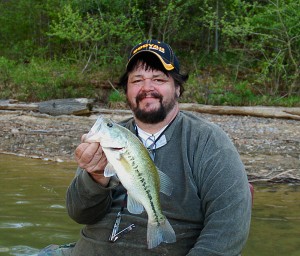Editor’s Note: This column first appeared in the Greater Ashland Beacon on Wed. Sept. 21, 2011.
By Chris Erwin
A chill has gripped the night air with temperatures falling into the 40s; the early-morning fog is thick as it lifts from the cooling water. The moon has just passed the full moon phase and many anglers are thinking about putting up their boats for the season. But Wait! Now is not the time to give up on the fishing season.
Every year, pleasure boaters start putting up their boats as the water falls into the 60s and deer bow season comes into play. Many anglers give up after the hot days of summer but now is when some of the most productive fishing trips can happen.
With falling water temperatures, the fish leave the bank line once the late-summer crawdad bite is over, making the fish seem to disappear. Casting the banks becomes less productive and the shallow-water brush that held fish all summer will dry up with little or no action. This along with the onset of the hunting season causes many anglers put away their rods thinking the fishing season is over.
But, just the opposite is true. As water temperatures fall, fish will start to tank up, adding body fat for the upcoming winter. All you have to do is stay on their movements. This requires a little work, but once you figure it out you can have days where you catch more fish in an hour than you were catching all day during the summer.

When we start into the fall transition, the shad will begin to school up and move to the heads of creek-fed coves. They usually start on points in the mouth of a cove then over a five or six week period they move toward the back of creeks. Once the transition is over, fish will return to the shallows and banks until the water temperatures get into the 50s. This is when they will move into deep winter locations.
One thing to keep in mind, is that this whole thing is triggered by plankton. Where the plankton is in the water table can vary according to sun-light, wind, current and temperature so your chore is to find the shad that is following the plankton. Once you find the shad you have half the pattern solved.
This is when your fish finder can earn its keep. Once you see the shad on your fish finder you can start your presentation. If the shad are four to six feet deep, pick baits that you know will run just above or below the shad. At times, you can even see the bass or crappie on your fish finder schooling under the shad. Baits like spinnerbaits, crankbaits and jigs are good baits to start with to build a pattern.
The key to catching these fish is depth, speed, color and action. If you know you have located the shad it’s time to find the right combination that these fish will hit. This is not a time to stay with that favorite lure that you have all your confidence in. Don’t keep doing the same thing and expect a different result. If you make eight or 10 casts and you don’t get a strike, change to something else. When you put the right factors together the fish will take your offering.
This time of the year you just might catch that trophy of a life time. All it takes is time on the water and learning a few new skills. You can do it! It will open up a whole new level of your fishing skills.
Till next time
Good Fishing
Chris Erwin is the founder and publisher of Kentucky Angling News. To reach Chris, e-mail him at trimmer308@windstream.net.


Be the first to comment